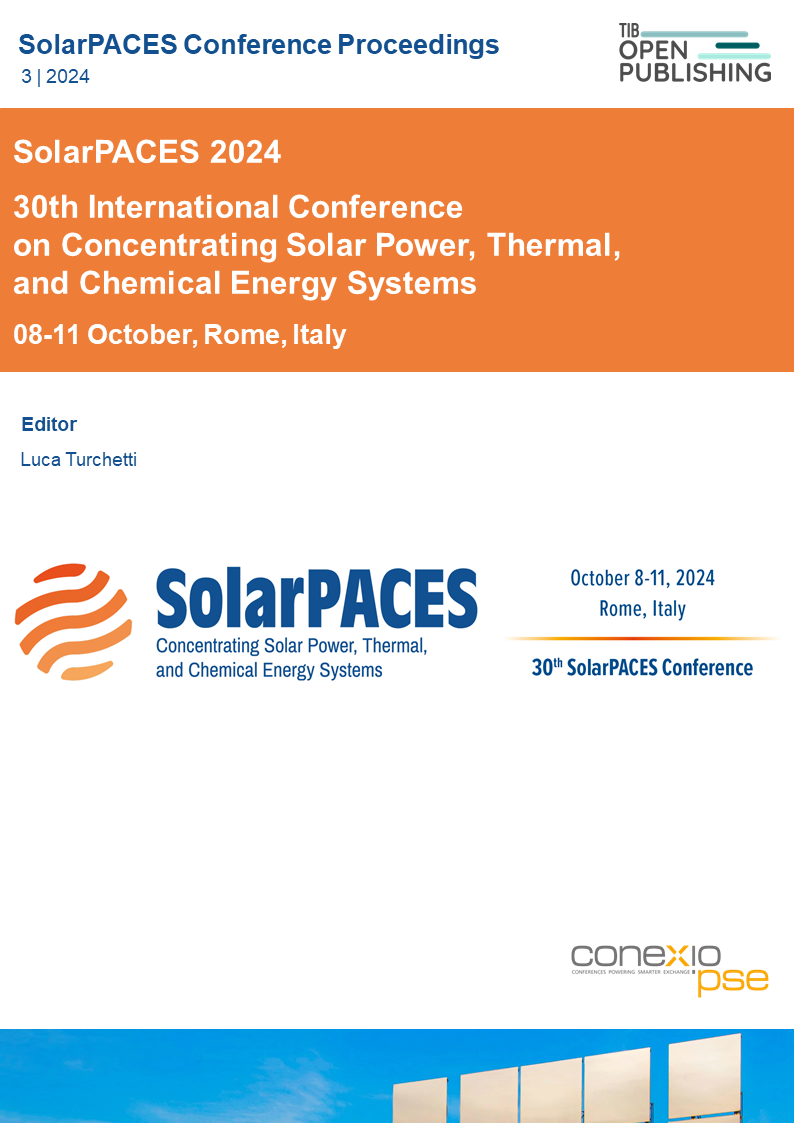Techno-Economic Analysis of a Solar Calciner for CO2 Emissions Reduction in the Chilean Cement Industry
DOI:
https://doi.org/10.52825/solarpaces.v3i.2340Keywords:
Cement Industry, Integration of Solar Calciner, Economic AnalysisAbstract
Clinker, constituting approximately 72% of cement's composition, is produced through an energy-intensive process that significantly contributes to CO2 emissions. This study explores the integration of a solar calciner into the Chilean cement industry, particularly in the Antofagasta region, which is characterized by high solar energy irradiation, with an annual DNI of 3,250 kWh/m2. This region also accounts for approximately 30% of the country's cement sector energy consumption. In this context, this study evaluates two Concentrated Solar Thermal (CST) scenarios: the Top of Tower (TT) system and the Beam-down (BD) system, assessing their technical and economic feasibility for reducing CO2 emissions in the calcination process. The findings suggest that both CST systems could substantially reduce CO2 emissions in the calciner. However, economic feasibility remains a challenge, primarily due to the low cost of coal, which is the main fuel in the Chilean cement industry. Additionally, the efficiency of the solar calciner is found to be crucial for achieving maximum emission reductions, for the scalability of the technology, and for its future adoption in Chile's cement industry. Although the Levelized Cost of Heat (LCOH) for the proposed plants is currently higher than the coal-fired calciners in which is produced about 90% of current clinker production in Chile, potential reductions in heliostat costs, coupled with an increase in carbon taxes beyond the current value of 5 USD/tCO2, could significantly improve the economic viability of CST plants in Chile's cement industry.
Downloads
References
[1] M. Ren, T. Ma, C. Fang et al., "Negative emission technology is key to decarbonizing China's cement industry", Applied Energy, vol. 329, p. 120254, 2023. ISSN: 0306-2619. DOI: 10.1016/j.apenergy.2022.120254.
[2] IEA, "International Energy Agency. Breakthrough Agenda Report 2023", International Energy Agency (IEA), 2023. [Online]. Available: https://www.iea.org/reports/breakthrough-agenda-report-2023.
[3] IEA, "International Energy Agency. Technology Roadmap - Low-Carbon Transition in the Cement Industry", International Energy Agency (IEA), 2018. [Online]. Available: https://www.iea.org/reports/technology-roadmap-low-carbon-transition-in-the-cement-industry.
[4] ICH, "Insituto del Cemento y del Hormigón de Chile - Hoja de ruta para el desarrollo de bajas emisiones en la Industria Chilena del Cemento", 2020. [Online]. Available: https://4echile.cl/wp-content/uploads/2020/09/TNA-Cemento_2020-07-20_Informe-FINAL.pdf.
[5] Solargis, "Solar Resource Maps of Chile", 2024. [Online]. Available: https://solargis.com/.
[6] M. Chase, NIST-JANAF Thermochemical Tables, 4th Edition, en, American Institute of Physics, -1, 1998-08-01 1998.
[7] S. Dieckmann, J. Dersch, S. Giuliano et al., "LCOE reduction potential of parabolic trough and solar tower CSP technology until 2025", AIP Conference Proceedings, vol. 1850, no. 1, p. 160004, Jun. 2017. ISSN: 0094-243X. DOI: 10.1063/1.4984538. [Online]. Available: https://doi.org/10.1063/1.4984538.
[8] W. Cole, C. Turchi, C. Augustine et al., "2022 Annual Technology Baseline (ATB) Cost and Performance Data for Electricity Generation Technologies", National Renewable Energy Laboratory (NREL), Tech. Rep. NREL/TP-6A20-80482, 2022. [Online]. Available: https://www.nrel.gov/docs/fy22osti/80482.pdf.
[9] R. S. González, and G. Flamant, "Technical and economic feasibility analysis of using concentrated solar thermal technology in the cement production process: Hybrid approach a case study", Journal of Solar Energy Engineering, Transactions of the ASME, vol. 136, May 2014. ISSN: 01996231. DOI: 10.1115/1.4026573.
[10] G. Moumin, M. Ryssel, L. Zhao et al., "CO_2 emission reduction in the cement industry by using a solar calciner", Renewable Energy, vol. 145, pp. 1578-1596, Jan. 2020. ISSN: 18790682. DOI: 10.1016/j.renene.2019.07.045.
[11] P. Schöttl, T. Zoschke, C. Frantz, Y. Gilon, A. Heimsath, and T. Fluri, "Performance assessment of a secondary concentrator for solar tower external receivers", AIP Conference Proceedings, vol. 2126, no. 1, p. 030052, Jul. 2019. ISSN: 0094-243X. DOI: 10.1063/1.5117564. [Online]. Available: https://doi.org/10.1063/1.5117564.
[12] Comisión Nacional de Energía, "Precios de los Combustibles - 2024", 2024. [Online]. Available: https://www.cne.cl/.
[13] A. Calderón, A. Palacios, C. Barreneche et al., "High temperature systems using solid particles as TES and HTF material: A review", Applied Energy, vol. 213, pp. 100-111, 2018. ISSN: 0306-2619. DOI: https://doi.org/10.1016/j.apenergy.2017.12.107.
[14] Ministerio de Energía de Chile, "Informe Balance Nacional de Energía 2020", Ministerio de Energía de Chile, 2022. [Online]. Available: https://energia.gob.cl/sites/default/files/documentos/2022_informe_anual_bne_2020.pdf.
Downloads
Published
How to Cite
Conference Proceedings Volume
Section
License
Copyright (c) 2025 Juan Sebastian Zuleta Marin, Gregor Bern, Frank Dinter, Werner Platzer

This work is licensed under a Creative Commons Attribution 4.0 International License.
Accepted 2025-05-02
Published 2025-10-14
